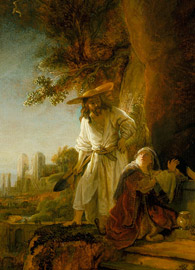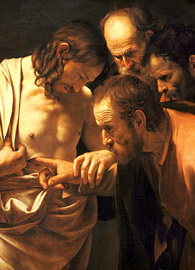John Week 10
To See or Not to See: Do You Now See…and Believe? (John 20)
Seattle Pacific University Assistant Professor of New Testament
Read this week’s Scripture: John 20
15:21
Key Prologue Terms: life, children of God, light overcoming darkness, belief, revelation, beginning
(In)sight and Perception
In 1998 two psychologists performed an experiment that is now famously referred to as “The Invisible Gorilla.” They asked students at Harvard University to watch a video as six people in different colored t-shirts passed a basketball back and forth. The students were supposed to count the number of passes that the people made. While counting these passes, half of the students completely missed the fact that an additional person in a gorilla suit walked into the middle of the action and then left. They did not see the gorilla.
The Gospel of John has been remarkably candid. Those who are blind are given sight, while those who claim to see are blind (John 9). Despite the fact that Jesus does not keep secrets or mysteries from his followers, no one seems to see him rightly. Their focus is elsewhere.
John’s resurrection narrative in chapter 20 proceeds through three main scenes:
- Mary Magdalene and other women discover the empty tomb.
- The beloved disciple and Peter run to the tomb and confirm that it is empty.
- Mary Magdalene encounters Jesus in the garden.
- Jesus meets the disciples in a room and gives them the Holy Spirit.
- Jesus confronts Thomas, who sees and believes.
Each scene focuses on one of these primary figures: Mary Magdalene, the beloved disciple, and Thomas. These central characters allow John to communicate the importance of responding to Jesus’ resurrection with faith — and what that faith entails. In each passage they will miss seeing the risen Jesus (the “gorilla,” by analogy), but gradually they begin to perceive rightly. [Author’s Note 1]
Setting: At the Tomb, in a Garden

 Enlarge
Enlarge
Before we consider Jesus’ resurrection appearances, John provides important information about the setting of these accounts. He describes a tomb available “in the place where [Jesus] was crucified” and says that no one ever had been laid in this tomb (19:41).
John explains that there were no other bones or other bodies in this new tomb. This is to clarify that when the tomb is found empty on Sunday morning (20:1–9), there can be no mistake. It was only Jesus’ body there in the first place. Mary’s only question is where Jesus’ body has been taken (20:2). [Author’s Note 2]
Lastly, it is theologically significant that Jesus’ burial and resurrection will take place in a garden. As a continuation of his instruction about new and abundant life, Jesus is here alluding to the original creation of Genesis 2 that focuses on the famous Garden of Eden (Genesis 2:4–24). By his resurrection, Jesus is both victorious over death — death no longer binds him — and he is also embodying the new creation (2 Corinthians 5:17) that is the kingdom of God.
A Relay Race: From Mary Magdalene to Two Disciples (20:1–10)
Mary Magdalene realizes that the stone has been moved from the tomb’s opening (not mentioned in John 19:38–42, but inferred from 11:38), and therefore she concludes that someone has moved the body (cf. Matthew 27:62–66; 28:11–15). [Author’s Note 3] She reports this fear to the disciples, namely Peter and the beloved disciple, and they immediately believe her. Just as Mary ran from the tomb to them, now they run to the tomb (20:3–4). It is hard to escape the fact that John describes this running in terms of a race, which the beloved disciple wins.
The Gospel of John contrasts the beloved disciple’s perception of events with Peter’s. The beloved disciple does not enter the tomb, but bends down, looks in the cave, and sees the linen wrappings (20:5). Joseph of Arimathea and Nicodemus had wrapped Jesus in pieces of linen, with many expensive spices (19:40). Unlike Lazarus, who brought his linen wrappings out of the tomb with him, symbolizing death’s continued hold on him, Jesus leaves his behind (11:44). [Author’s Note 4]
Peter breezes by the beloved disciple, goes in the tomb, and sees not only the linen wrappings but also the head cloth (20:6–7). All of these wrappings were mentioned as still on Lazarus in John 11 (11:44) as he emerged from the tomb. The implication is that we are dealing with a similar event — resurrection — but the conclusion is very different. This time, death itself has been defeated. The beloved disciple seems to come to a similar conclusion, in that he “saw and believed” (20:8). John does not specify what the beloved disciple believed, and he goes on to clarify that the disciples still need to understand the Scriptures and the necessity of resurrection (20:9).
Finally, the statement that “the disciples returned to their homes” seems almost laughable (20:10). Was this a returning in confusion — they too, like Mary, did not know what had happened? What did the beloved disciple believe, and why does he also return home? In a way, this statement simply stands in contrast to Mary’s actions: she is still in the garden, weeping by the tomb (20:11).
Mary looks in the tomb and sees two angels. The angels ask her why she is crying, addressing her the same way that Jesus addressed his mother at the wedding at Cana (“Woman,” 2:4). She restates her first claim: she does not know where Jesus is (20:13). No one has been able to help her. The angels apparently disappear, and Mary is left with Jesus but does not recognize him. She can see him, but she does not perceive who he is (20:14). Jesus restates the angels’ question, following it up with “whom are you seeking?” (20:15; author’s translation).
John reiterates the setting by stating that Mary has mistaken Jesus to be the gardener. Just as God “gardened” in the Garden of Eden and passed the task of taking care of creation on to Adam (Genesis 2:8–9, 15), so we are to hear echoes of God’s presence in the resurrected Jesus here. After his resurrection, Jesus’ appearance is at least concealed enough that he is not immediately recognizable to those who know him well. This enables Jesus to reveal himself to those he desires. His revelation to Mary comes as he calls her name (20:16), and she responds by calling him her Teacher (see also 1:38, 49).
While John’s gospel does not say that Mary touches Jesus, it does preserve a rather cryptic verbal reply to Mary’s exultation. Jesus says, “Do not hold on to me, because I have not yet ascended to the Father. But go to my brothers and say to them, ‘I am ascending to my Father and your Father, to my God and your God’” (20:17). At first glance Jesus’ reply seems to forbid Mary from touching him, implying that he is somehow not really human after his resurrection. This implication could not be further from the truth, as the rest of John’s gospel demonstrates. [Author’s Note 5]
Seeing and Not Seeing: Behind Closed Doors

 Enlarge
Enlarge
Later that same day, the disciples — apparently even after hearing Mary’s message — are hiding behind locked doors “for fear of the Jews” (20:19). This phrase has been used throughout the gospel (see 7:13; 9:22; 19:38) to refer to fear of the Jewish authorities specifically, as it is Jews (Jesus’ disciples, among others) who are described as being afraid. This fear is not a positive response. In the gospel tradition, fear is often the enemy of faith. The disciples’ fear has apparently prevented them from taking action on Mary’s proclamation, on the beloved disciple’s faith (20:8), or on Peter’s observations of the empty tomb (20:6). They have “let [their] hearts be troubled,” as Jesus has just instructed them not to do (14:27).
The antidote to the disciples’ fear is Jesus’ presence, as he offers them peace (20:19; cf. 14:27). By showing the disciples his hands (the word can include forearms, where the nails would have held him to the cross) and his side, Jesus confirms that he is the same one who died and is back with them again. Moreover, resurrection does not erase his scars, but now they are part of who he is, the Crucified and Risen One.
The focus does not remain on Jesus’ body, however. The disciples respond in joy as they see “the Lord,” just as Mary Magdalene did in the garden (20:20; cf. 20:18). Jesus now commissions the disciples to go out in peace (20:21) and with the Holy Spirit (20:22). We should hear echoes of Jesus’ conversation with Nicodemus when Jesus gives the disciples the Holy Spirit, as John again uses a play on words: Jesus breathes the Holy Spirit onto the disciples, where in the Greek, breath and s/Spirit are the same word (cf. 3:8).
Jesus breathing the Spirit onto his disciples is another allusion to God’s creation in the Garden of Eden: the first human being comes to life once God breathes on him (Genesis 2:7). Now the disciples come to life again – one might say they are reborn – with Jesus’ breath. The gift of the Holy Spirit in John is primarily summarized in terms of forgiveness and reconciliation (20:23; see further, John 21:15–19). Being able to judge sins and to forgive is a way in which the community continues Jesus’ role on earth (see also Matthew 16:19; 18:18). Therefore Jesus’ model of forgiveness and reconciliation in John 20–21 is essential teaching for the church’s action. [Author’s Note 6]
John continues to focus again on one individual’s reaction to Jesus. He provides a personal encounter with one of the “doubters” Matthew mentions (Matthew 28:17). Ostensibly Thomas doubts because he has not seen Jesus. Again we find the metaphor of physical sight standing in for spiritual insight: Thomas cannot claim spiritual insight — faith/belief — because he does not believe the disciples’ testimony. He must see Jesus and touch Jesus’ wounds for himself (John 20:24–25).
Jesus appears again on the following Sunday (20:26), and this time all the disciples are gathered together in the same place. Jesus grants the disciples his peace and, apparently without preamble, extols Thomas to touch his wounds. He then says, “Do not be unfaithful, but faithful” (20:27, author’s translation). Upon seeing Jesus and hearing this proclamation, readers are not told that Thomas carries out his plan: he can be faithful, he can believe, without touching Jesus’ wounds. Here Thomas cries out a complete confession of faith, calling Jesus “my Lord and my God” (20:28; Author’s Note 7).
Jesus’ reply includes no reproach for Thomas. Rather, he simply blesses the hearers of John’s gospel, who have not seen and yet have come to believe (20:29). This blessing should remind readers of the beloved disciple. Even without seeing the risen Jesus, and only seeing the empty tomb and the linen wrappings, this disciple is able to have faith (20:8). This beloved disciple is a model of the ideal disciple of Jesus in some ways. The disciple is close to Jesus’ heart, just like Jesus is close to the Father’s heart (13:23; 1:18). He is part of Jesus’ family (19:26–27). And he believes without having to see.
Jesus does not demean those like Thomas who crave sight in order to be faithful. Yet Jesus has spoken often of his impending absence. Future disciples will not have the luxury Thomas did, and yet they too will be faithful to the risen Lord. Such insight in the invisible is a product of both the Holy Spirit (20:22–23) and the loving community of the disciples, who abide in Jesus and who live out his love to the world.
Not Quite the End
John 20 concludes with a clear statement of purpose: this gospel was written “so that you may come to believe that Jesus is the Messiah, the Son of God, and that through believing you may have life in his name” (20:31).
Many characters have been described as believing something in John 20, often the fact of Jesus’ resurrection. Here, however, the evangelist claims that the purpose of reading this gospel is two-fold. One purpose is faithfulness, or belief. The reader should be able to come to believe intellectually that Jesus is who he has claimed to be. He is the Messiah, the deliverer of Israel and all of God’s children (1:12). He is the Son of God doing the will of the Father (1:18; 5:19–30). The second purpose is that such faithfulness or belief must be lived out. Jesus has not come to change people’s minds, but to change their lives. The salvation of the world, eternal life itself, is not something that is entirely located in the future.
In fact, this is one of the key points of Jesus’ work on earth: eternal life, or life without decay, sin, and death, has begun here and now. The signs of Jesus’ ministry (water to wine, healings, miraculous feedings, forgiveness, resurrection) point to this reality. New life has broken onto the scene of a dead and fragmented world. The task of the readers of the gospel is to see and then testify — to be faithful — to this Jesus with their new lives. The Gospel of John exhorts us not to miss this new life because we are too focused on our old lives to see what is in plain sight. This time there is far more at stake than a gorilla.
Questions for Further Reflection
- Put yourself in the shoes of those who first encountered the risen Jesus. Are you most like the beloved disciple? Like Mary Magdalene? Like Thomas? Why? And what would the risen Jesus tell you, or ask you, to do?
- Compare the resurrection account in John 20 to those in Matthew 28, Mark 16, and Luke 24. What themes do you think John was specifically trying to emphasize?
- What are ways in which your life has been made new by Jesus’ new life/resurrection? What are ways that it still needs to be made new?
<<Previous Lectio Back to John Next Lectio>>

This work is licensed under a Creative Commons License.





I’ve really enjoyed this Lectio series. Thanks for sharing your insights. I’ve been drawn to some of the Old Testament allusions and really appreciated your discussion of the new garden theme. The details of the angels interest me. Their placement in the tomb causes me to picture something like the Ark of the Covenant. Just wondering if there is any connection there and have been pondering the potential significance.